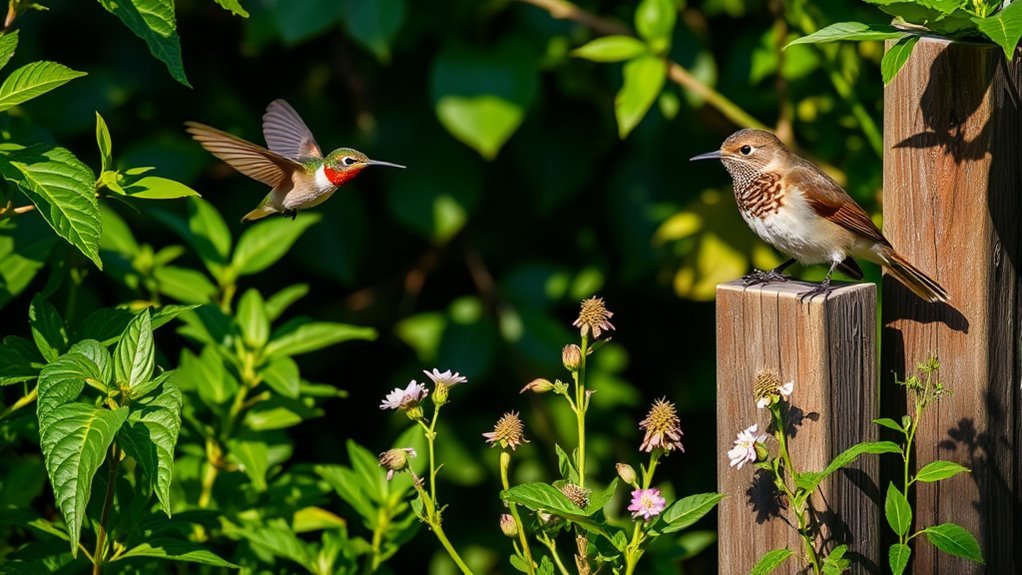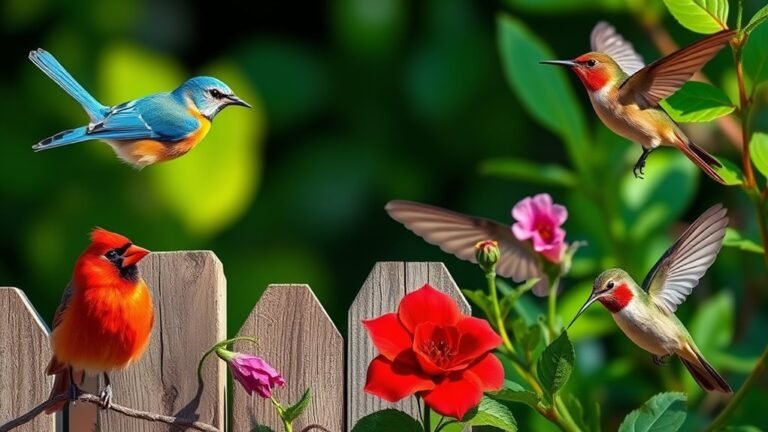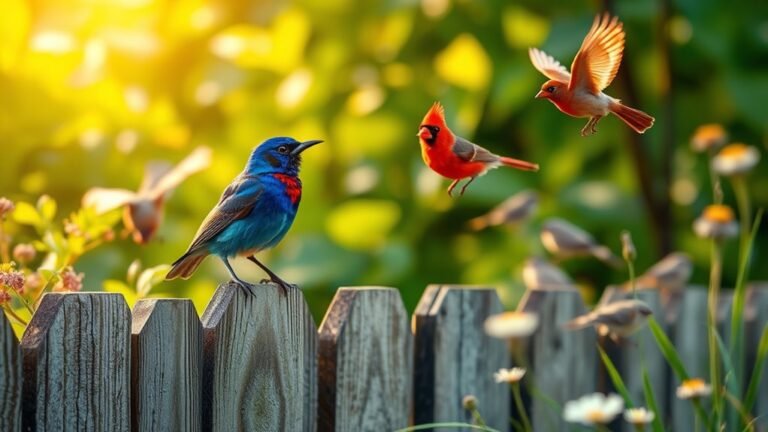Kentucky Local Backyard Birds
In Kentucky, you can see many types of backyard birds. The American Robin and Northern Cardinal are common. Watching these birds gives you a chance to learn about their diets and mating habits. Different seasons bring new challenges for them. Each bird has special ways to adapt and survive in their environment. Observing these behaviors can be both interesting and rewarding. Enjoy watching the lively interactions of these beautiful birds in your backyard.
Key Takeaways
- Common backyard birds in Kentucky include the American Robin, Northern Cardinal, Eastern Bluebird, Mourning Dove, and Dark-eyed Junco.
- Observing size, shape, and color aids in identifying different bird species in your backyard.
- Installing bird feeders with sunflower seeds can attract a variety of local birds.
- Seasonal changes influence bird populations, with unique species visible in spring, summer, fall, and winter.
- Understanding bird behaviors, like territorial singing and feeding habits, enhances your birdwatching experience.
Common Backyard Birds of Kentucky
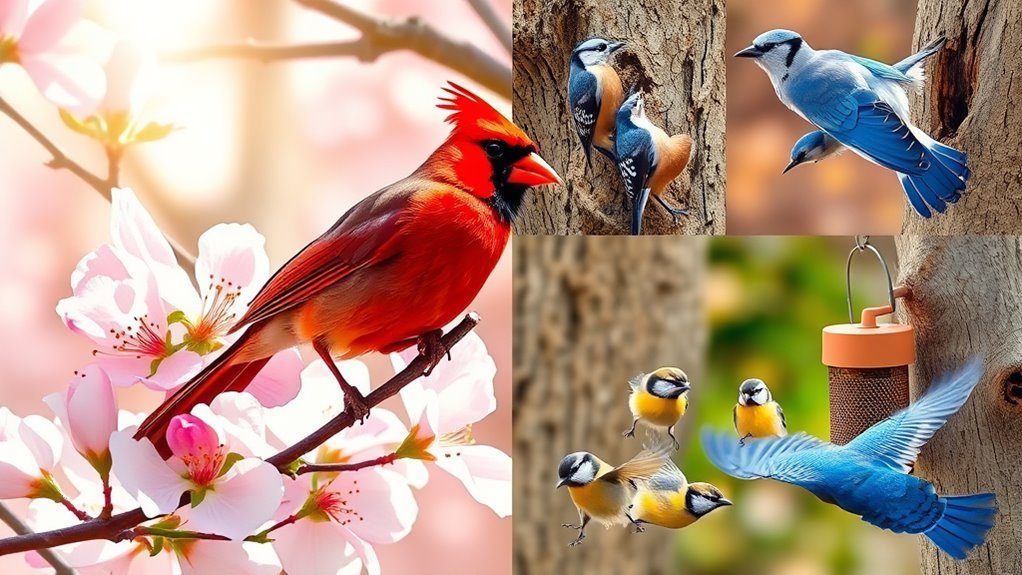
In your Kentucky backyard, you'll see various birds that live in this area. Common birds here include the American Robin, known for its bright orange breast, and the Northern Cardinal, which has bright red feathers and a distinctive crest.
Listen for the songs of the Eastern Bluebird, often found sitting on a fence, and the soft calls of the Mourning Dove that bring a calming feel to your mornings.
Watching these birds helps you connect with nature and appreciate their unique behaviors and traits in your Kentucky home. Enjoy the simple pleasure of observing these lovely backyard birds.
Identifying Kentucky's Feathered Residents
When you watch birds in your Kentucky backyard, improving your identification skills can make it more enjoyable.
Start by observing their size, shape, and color. Look for unique feather patterns, like the bold markings of a Northern Cardinal or the soft shades of a Blue Jay.
Notice their behaviors, such as how they interact with each other, what they eat, and their flight patterns.
Use birdwatching guides or apps to help you learn more about the birds you see.
Each experience with these birds can increase your love for nature and help you feel connected to the diverse birdlife in Kentucky.
Enjoy your journey of discovery!
Attracting Birds to Your Backyard

Creating an inviting backyard can help attract a variety of birds. Start by placing bird feeders filled with seeds like sunflower and nyjer. These seeds attract many bird species. Position the feeders near shrubs and trees, which offer birds a sense of safety.
Add a water source, such as a shallow birdbath, to encourage birds to visit for drinking and bathing.
Planting native plants provides food and shelter, attracting insects that many birds need. Keep your yard clean and free from harmful chemicals to maintain a welcoming environment.
Understanding Bird Behavior
Understanding bird behavior is important for anyone who wants to attract and enjoy these amazing animals in their backyard.
By watching them, you can learn about how they communicate and establish territory, which are crucial for their survival and reproduction.
- Communication: Listen for different calls and songs. Birds use these sounds to show their feelings or warn of threats.
- Territoriality: Watch male birds as they defend their territory. They often do this by singing or displaying their strength.
- Feeding Patterns: Observe how they feed. Each species has specific preferences and methods for finding food.
Seasonal Changes in Bird Populations
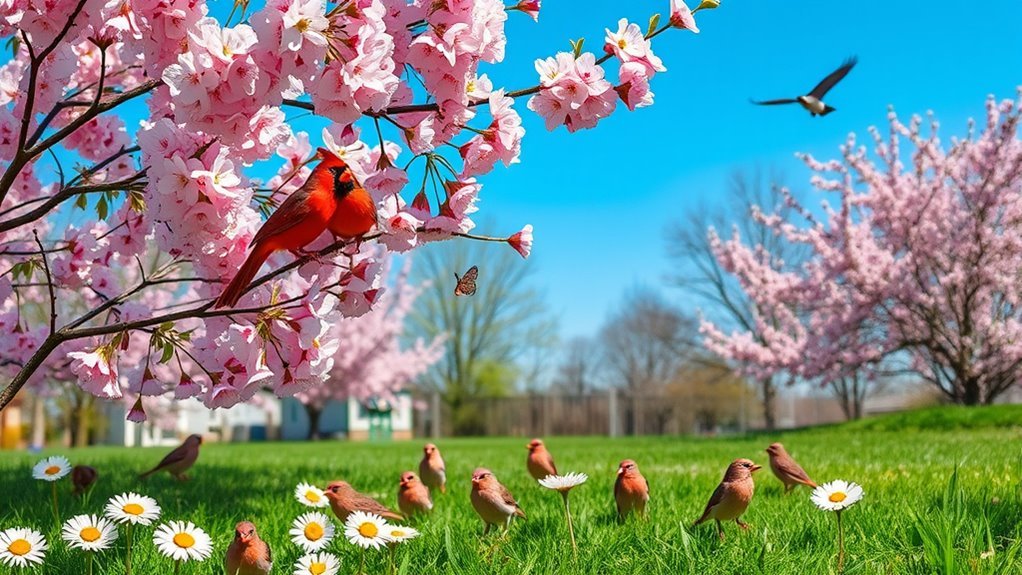
As the seasons change, bird populations in your Kentucky backyard also change.
In spring, you'll see resident birds like the Eastern Bluebird become more active. They display their bright colors and engage in courtship.
As summer shifts to fall, migration begins. Birds such as the Ruby-throated Hummingbird will start their journey south.
When winter arrives, your backyard will attract hardy birds like Dark-eyed Juncos and American Goldfinches. These birds come to find food in colder temperatures.
Each season brings different behaviors, from nesting in spring to foraging in winter.
Observing these changes connects you to the vibrant bird life around you. Enjoy the beauty and variety that each season brings to your backyard.
Feeding and Watering Strategies for Backyard Birds
To attract various backyard birds, provide consistent food and fresh water.
Position bird feeders and water sources effectively for the best results.
Here are some straightforward strategies:
- Select Suitable Feeders: Use tube feeders for small birds and platform feeders for larger ones. This approach helps accommodate different bird types.
- Provide Diverse Foods: Offer seeds, suet, and nectar to attract a wide range of birds. This variety will enrich your backyard ecosystem.
- Ensure Fresh Water: Regularly refill water sources and add bird baths. Clean, fresh water creates a welcoming space for birds.
Implementing these strategies will help you attract a lively mix of birds to your backyard.
Enjoy watching them thrive!
Nesting Habits of Kentucky Birds
Many people enjoy watching birds at feeders. However, the nesting habits of Kentucky birds are also interesting. Different species, such as the Eastern Bluebird and the American Robin, choose various nesting spots like trees, shrubs, or man-made structures.
The breeding behaviors of these birds are unique. Many participate in courtship displays to attract a mate. After pairing, they build nests using local materials like twigs, grasses, and feathers.
Observing these activities in your backyard can strengthen your connection to nature. If you're patient, you may see fledglings leaving their nests. This new life can bring excitement to your yard and create a sense of community among bird watchers.
Embrace the joy of birdwatching and explore the nesting habits of the birds around you.
Conservation Tips for Local Bird Species
To help local bird species in Kentucky, you can take simple actions in your yard.
These actions can support wildlife and improve biodiversity. Here are some effective strategies:
- Create a habitat: Plant native plants in your yard. These plants provide food and shelter for birds.
- Connect spaces: Link your yard to nearby parks or natural areas. This allows birds to move easily between habitats.
- Reduce risks: Use bird-safe glass or decals to prevent window strikes. Keep cats indoors to protect birds.
Frequently Asked Questions
What Are the Best Times to Observe Kentucky Backyard Birds?
To see backyard birds best, go outside in the morning. Birds search for food during this time. Evening twilight is also a great time to watch them as they get ready for nesting. Observing at these times helps you witness different bird behaviors, making your birdwatching experience enjoyable and rewarding.
How Do Weather Changes Affect Local Bird Activity?
Weather changes significantly affect local bird activity. Temperature shifts lead to seasonal migrations. Birds move to find food and suitable nesting sites. These changes influence their feeding habits and behaviors. Observing these patterns can deepen your connection to nature and its cycles.
Are There Specific Plants That Attract Kentucky Birds?
To attract local birds in Kentucky, plant native plants near your bird feeders. Native plants provide seeds and shelter, creating a friendly space for various birds. This will increase bird activity in your garden, allowing you to enjoy their vibrant presence. Consider options like Black-eyed Susans, Purple Coneflowers, and New England Asters. These plants not only enhance your garden's beauty but also support local wildlife. Enjoy watching birds thrive as they find food and shelter in your yard.
Can I Train Backyard Birds to Come to Me?
You can train backyard birds to come to you. Start by feeding them regularly in the same spot. Choose high-quality bird food that birds enjoy. Be consistent with your feeding times to help them recognize when to expect food.
Observe how the birds behave around your feeding area. This will help you understand their habits and build trust. Over time, as they feel safe, they'll visit more often. Create a welcoming space with natural features like plants or birdbaths to attract them.
Remember to be patient. It may take time for birds to feel comfortable coming close to you. Enjoy the process of watching them learn and interact in your yard.
What Sounds Do Common Kentucky Birds Make?
Birds make many sounds, and each one helps you identify them. Listening closely to bird songs and calls can help you learn about different species. Each sound may show how birds behave and interact in their environment. Enjoy watching and listening to these common Kentucky birds, and discover the stories their voices share.

Hello, I’m Amelia White, the founder of birdsfanatic.com. As a lifelong bird enthusiast and spiritual seeker, I’ve always been fascinated by the mystical connections between birds and the human experience. On this site, I share my knowledge and insights into the symbolic meanings and spiritual significance of various bird species, exploring their roles in mythology, folklore, and cultural traditions. Join me on this journey into the world of birds, where we’ll discover the hidden wisdom and guidance that these magnificent creatures have to offer.

